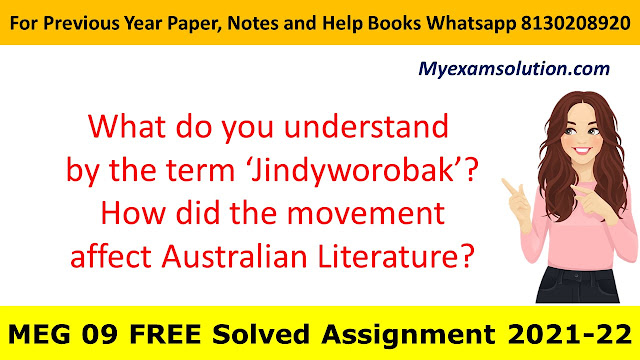What do you understand by the term ‘Jindyworobak’? How did the
movement affect Australian Literature?
The movement affect Australian Literature. The Jindyworobak Movement was an Australian scholarly development of the 1930s and 1940s whose white individuals, generally writers, tried to add to a The movement affect Australian Literature. remarkably Australian culture through the reconciliation of Indigenous Australian subjects, language and folklore. The development's expressed point was to "free Australian workmanship from whatever outsider impacts hamper it" The movement affect Australian Literature. The movement affect Australian Literature. and make works dependent on a commitment with the Australian scene and an "comprehension of Australia's set of experiences and customs, antiquated, pilgrim and current". The movement affect Australian Literature.
The development started in
Adelaide, South Australia, in 1937, when Rex Ingamells and different artists
established the Jindyworobak Club. Ingamells laid out the development's points
in a location entitled On Environmental Values (1937). "Jindyworobak"
comes from the Woiwurrung language, The movement affect Australian Literature. in
the past spoken around advanced Melbourne, signifying "to join" or
"to add-on". It was utilized by James Devaney in his 1929 book The
Vanished Tribes, wherein he professes to have obtained it from a nineteenth
century jargon. Ingamells is said to have picked the word because of its
extraordinary and representative characteristics. The name was some of the time
abbreviated to "Jindy", and "Jindys" came to allude to
individuals from the gathering, which included Nancy Cato, Ian Mudie and Roland
Robinson. The movement affect Australian Literature.
The Jindyworobaks tracked
down motivation in the Australian shrubbery anthem custom, Kangaroo (1928) by
D. H. Lawrence and P. R. Stephensen's The Foundations of Culture in Australia
(1936), and shared a dream like that of a portion of their counterparts in
human expression, for example, creator Xavier Herbert, craftsman Margaret
Preston and arranger John Antill. In any case, the development likewise pulled
in analysis for being socially separate and plainly patriot. The Jindyworobak
Anthology was distributed yearly from 1938 to 1953, and the Jindyworobak Review
(1948) gathered the initial ten years of this distribution. A broad history of
the development, The Jindyworobaks, was distributed in 1979.
The movement affect Australian Literature.
Getting going as a scholarly
club in Adelaide, South Australia in 1938, the Jindyworobak development was
upheld by numerous Australian specialists, artists, and essayists. Many were
entranced by Indigenous Australian culture and the Outback, and wanted to
further develop the white Australian's agreement and enthusiasm for them.
Different highlights became possibly the most important factor, among them
white Australia's expanding estrangement from its European starting points; the
Depression of the 1930s which reviewed the monetary difficulties of the finish
of the nineteenth century; an inexorably metropolitan or rural Australian
populace distanced from the wild Australia of the Outback and so on; the First
World War and the happening to World War II and furthermore the happening to
early mass market media as the radio, accounts, papers and magazines. Feeling
of spot was especially essential to the Jindyworobak development.
The movement affect
Australian Literature. Ingamells delivered Colonial Culture as a writing
statement of the development, "because of L. F. Giblin's encouraging that
writers in Australia ought to depict Australian nature and individuals as they
are in Australia, not with the 'European' look." and soon after the main
Jindyworobak Anthology came out. The movement affect Australian Literature.
In 1941, the writer and
pundit A. D. Trust scorned the Jindyworobaks as "the Boy Scout school of
verse", a remark for which he was sorry in Native Companions in 1975
saying "some alters are expected, I think, to these
Jindyworobaks".[2] Others like R. H. Morrison scorned "Jindyworobackwardness".
Hal Porter composed of meeting Rex Ingamells who he said "gets me a
watchman gaff and attempts to convince me to be a Jindyworobak - that is, a
writer who believes that words from the moment jargon of the world's most crude
race should be utilized to communicate Australia".
Despite the fact that
"Jindies" focused on Australian culture, not all were of Australian
beginning—for instance, William Hart-Smith, who is once in a while associated
with the development, was brought into the world in England, and consumed a
large portion of his time on earth in New Zealand following 10 years
(1936–1946) in Australia.
Treasurys of Jindyworobak
material were delivered until 1953.Arguably, the development neglected to
establish a long term connection, and its disintegration flagged the appearance
of pioneer painting in Australia, just as jazz. No Indigenous Australians were
individuals from the development, however it did in a roundabout way prod
business interest in Indigenous Australian workmanship.
Judith Wright wrote in
Because I was Invited in 1975 that the development had prevailed with regards
to carrying verse into the public field:
"One thing the
development accomplished was to make section a subject of discussion and
contention. Resistance developments jumped up, and brought into the squabble
most rehearsing writers of any height. The Jindyworobak's fundamentals were
talked about, and their more extreme perspectives, for example, response to
'Aboriginality' was scorned, even in the every day papers (which around then
were barely fields for scholarly discussion)."
Likewise, large numbers of
Australian writing's senior statespeople, some actually living today, got their
gets through the Jindyworobak development.
Brian Matthews composed during
the 1980s that:
"At the point when
Ingamells investigated the verse scene from the viewpoint of, say, 1937 – which
he conveyed his location On Environmental Values to the English Association in
Adelaide – he saw next to no verse which fulfilled the necessity of Australian
motivation, Australian substance and symbolism, and when Max Harris overviewed
a similar scene toward the beginning of the new decade, he saw the prospering
Jindyworobaks and very little else – nothing that appeared to have a lot of association
with or attention to the social world past the antipodes. Also all things
considered, they were both right." (passage from Literature and Conflict).
The movement affect Australian Literature.
